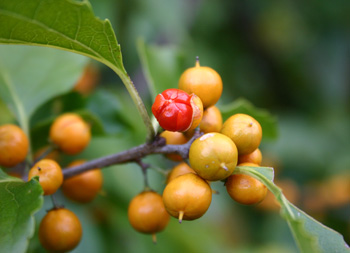Contents:
Common Names | Parts Usually Used | Plant(s) & Culture | Where Found | Uses | Warning | Bibliography
Scientific Names

- Celastrus scandens L.
- Celastrus orbiculatus
- Staff tree family
Common Names
- American Bittersweet
Parts Usually Used
Bark of root
Back to Top
Description of Plant(s) and Culture
Climbing, twining shrub; grows to
Back to Top
Where Found
Rich thickets from Quebec to Georgia; Alabama, Oklahoma to North Dakota.
Back to Top
Uses

Root-bark tea induces sweating; diuretic, emetic. Folk remedy for chronic liver and skin ailments, rheumatism, leukorrhea, suppressed menses. Externally; bark used in ointment for burns, scrapes, skin eruptions. American Indians used this plant as above, also used astringent leaf tea for diarrhea, dysentery. Root-bark tea is used for pain of childbirth. Bark extracts thought to be cardioactive.
Back to Top
Warning
Fruits are toxic. All parts potentially toxic.
This herb should not be used without medical supervision.
Back to Top
Bibliography
![]() Eastern/Central Medicinal Plants
Eastern/Central Medicinal Plants, by Steven Foster and James A. Duke., Houghton Mifflin Company, 215 Park Avenue South, New York, NY 10000
 How Indians Use Wild Plants for Food, Medicine & Crafts
How Indians Use Wild Plants for Food, Medicine & Crafts, by Frances Densmore, Dover Publications, Inc., 180 Varick Street, New York, NY 10014, first printed by the United States Government Printing Office, Washington, in 1928, this Dover edition 1974
![]() American Folk Medicine
American Folk Medicine, by Clarence Meyer, Meyerbooks, publisher, PO Box 427, Glenwood, Illinois 60425, 1973
![]() The Complete Medicinal Herbal
The Complete Medicinal Herbal, by Penelope Ody, Dorling Kindersley, Inc, 232 Madison Avenue, New York, NY 10016, First American Edition, copyright 1993
![]() Indian Herbalogy of North America
Indian Herbalogy of North America, by Alma R. Hutchens, Shambala Publications, Inc., Horticultural Hall, 300 Massachusetts Avenue, Boston, Massachusetts 02115, 1973
